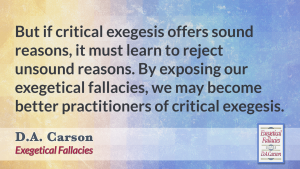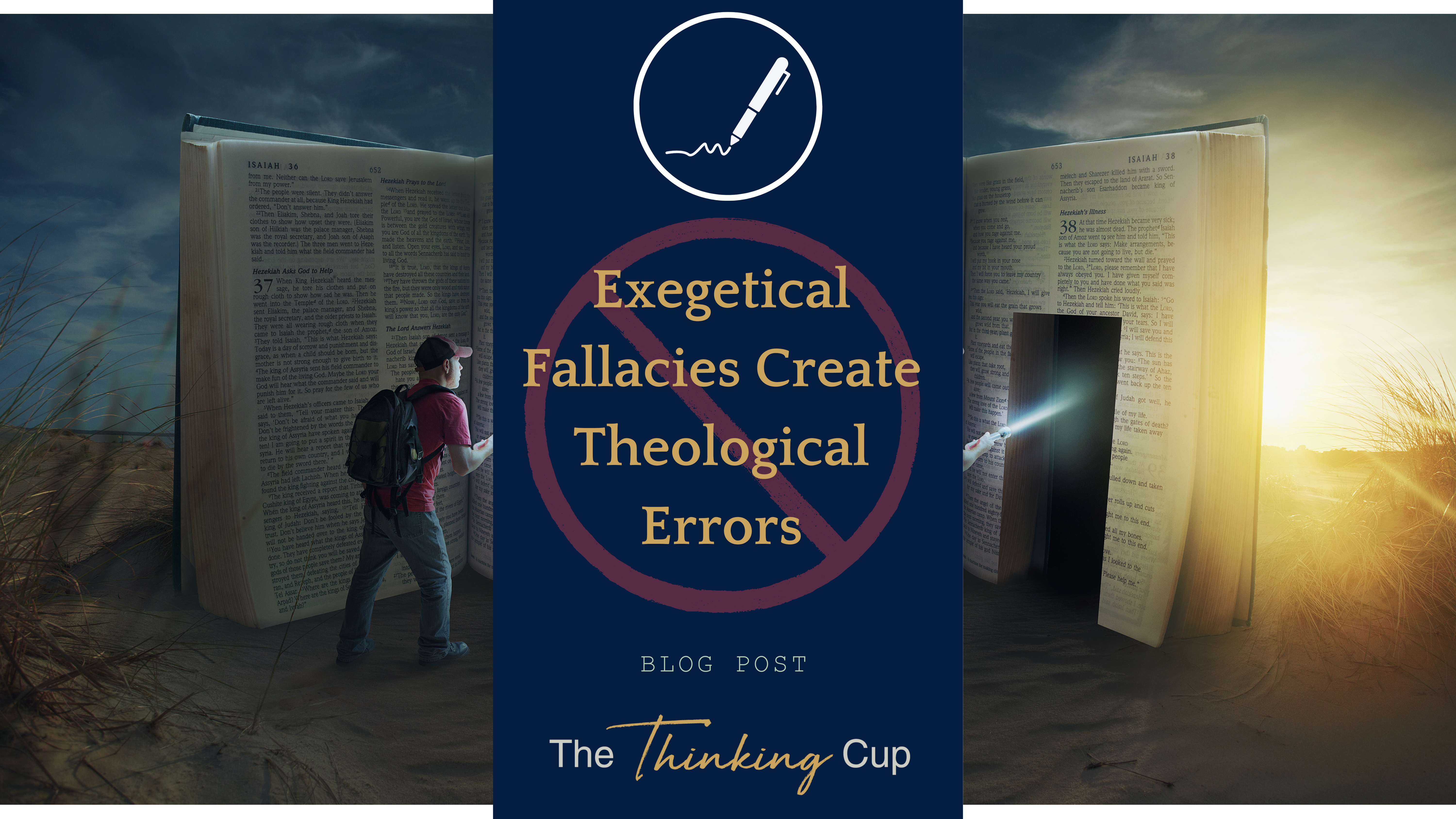YES, YES, YES!

Thank you, D.A. Carson, for the reminder! This is just another reason I push so hard to seek sound exegesis with Scripture! Let the text be what it is—an Ancient Text. I struggle to honor the text for what it is. I get it. The struggle is real. But if we aren’t aware of the potential exegetical fallacies in the first place, how will we know when we fall into these interpretive traps?
What exegetical fallacies have I seen the most inside the Seventh-day Adventist Framework?
Here are just a few that I come across regularly:
- Overemphasis on Proof Texting
Fallacy: Proof texting pulls isolated verses from their immediate and broader biblical context to support a preconceived theological doctrine.
Example in SDA Theology: The doctrine of the investigative judgment is based heavily on Daniel 8:14 (“unto 2,300 evenings and mornings; then shall the sanctuary be cleansed”). When removed from its immediate and historical context, this verse is given a meaning (investigative judgment starting in 1844) that is disconnected from its original intention in the text.
- Etymological Fallacy
Fallacy: This occurs when the meaning of a word is assumed based solely on its root or historical development rather than its usage in context.
Example in SDA Theology: Some Adventists use the etymology of the word “Sabbath” to argue that it universally mandates rest on the seventh day, without fully considering the broader context of New Testament teachings on Sabbath observance (e.g., Colossians 2:16–17, Romans 14:5).
On the issues of the Sabbath, you are invited to join our first ever Live Q&A on the Sabbath and the Law with special guest E.J. ‘Thunder’ Lauriston on April 10th at 6 PM CST.
https://www.youtube.com/live/v7QGbzwVMTI
If you have questions you want covered, please complete this form: https://thethinkingcup.com/live-qanda-submission/
We will first cover any questions submitted and then cover live questions.
- False Dichotomies
Fallacy: Presenting a debate or interpretation as having only two options, often for polemical purposes.
Example in SDA Theology: The conflict between law and grace is sometimes portrayed in a way that emphasizes the necessity of law observance (e.g., keeping the Sabbath) rather than viewing grace as the sole basis of salvation. Yes, I understand Adventist, that you think obedience comes from love… but your Prophetess claimed that obedience maintained your justification!
“But while God can be just, and yet justify the sinner through the merits of Christ, no man can cover his soul with the garments of Christ’s righteousness while practicing known sins, or neglecting known duties. God requires the entire surrender of the heart, before justification can take place; and in order for man to retain justification, there must be continual obedience, through active, living faith that works by love and purifies the soul.” [1]
This can create tension between obedience and spiritual freedom, potentially misrepresenting the New Testament’s teaching on grace.
This issue popped up multiple times in my debate with Matt Morea. I’ll be doing an ADL Review of this debate to showcase this common issue, among many other exegetical errors! Subscribe to the YouTube channel and get notified!
- Reading Modern Issues into Ancient Texts (Anachronism)
Fallacy: Reading modern understandings, events, or doctrines back into biblical texts that were written in entirely different historical and cultural contexts.
Example in SDA Theology: The identification of the Roman Catholic Church and the Papacy as the primary fulfillments of the prophecies in Daniel and Revelation (e.g., the “little horn” of Daniel 7 and the “beast” of Revelation 13). This reflects a Reformation-era polemic that does not align with the texts’ original intent or broader eschatological themes. Anachronism pops up a lot, not only with Seventh-day Adventism but inside of Christianity at large. It’s an easy exegetical fallacy to fall prey to.
- Over-Dependence on Typology
Fallacy: Overextending typology by finding symbols, types, and patterns in the Old Testament that are not clearly affirmed in the New Testament.
Example in SDA Theology: The typological interpretation of the earthly sanctuary as a direct representation of a heavenly sanctuary (as seen in the investigative judgment doctrine) goes beyond the explicit connections made in the Bible. This imposes an unnecessary theological framework on the text. One that isn’t presented to the original authors or audience. This example violates the ‘only approved interpretive method’ of the Seventh-day Adventist Church: the Historical Grammatical Method. (According to Ted Wilson, GC President)
- Selective Use of Scripture
Fallacy: Focusing on specific passages while ignoring others that may challenge or balance a given doctrinal position.
Example in SDA Theology: The Adventist emphasis on commandments like Sabbath observance downplays Pauline texts that emphasize freedom in Christ and the fulfillment of the law in Him (e.g., Galatians 3:24–25, Romans 10:4). This creates a perceived imbalance in the biblical narrative. Many Adventists experience cognitive dissonance when dealing with these types of topics because the interpretation inside the Adventist framework dismisses texts or plain ignores texts that don’t align with their understanding.
- Excessive Literalism
Fallacy: Taking figurative or symbolic language in the Bible literally when context suggests it is metaphorical or symbolic.
Example in SDA Theology: The interpretation of prophetic time periods as literal years (the day-year principle) is common in SDA eschatology, e.g., the 1,260, 1,290, and 2,300 “days” in Daniel and Revelation. This method of interpretation is not warranted by the text itself, particularly given the highly apocalyptic and symbolic genres of these books. Nothing in the text prescribes the ‘day equals a year’ interpretation. This is assumed upon the text from their desire to be excessively literal when dealing with these eschatological dates. What makes it even more confusing is that some use the formula and some don’t. What interpretive standard is used to determine when the ‘day equals a year’ method is what the author intended to be used?
- Isolation of Ellen G. White’s Writings
Fallacy: Giving authority to an external interpretation and using it as the foundation for biblical exegesis rather than drawing conclusions from Scripture alone. (Almost ALL Adventists think they ONLY use the Bible for their understanding. This is another blind result of this fallacy)
Example in SDA Theology: While the Bible is officially upheld as the supreme authority in Adventism, Ellen G. White’s extensive writings often function as interpretative keys. In the history of the Adventist movement, her visions and writings were used to stamp the movement’s interpretations as ‘approved and sound in doctrine.’ This reliance risks creating a circular logic where her interpretations are read back into Scripture. Thus creating a false perception that everything the Adventist church teaches is grounded in the Bible. This is fundamentally flawed because of the use of Ellen White’s writings as the lens through which all understanding must align.
- Misapplication of Apocalyptic Literature
Fallacy: Misinterpreting or overinterpreting symbolic, apocalyptic genres as predictive of specific events or timelines.
Example in SDA Theology: The historicist approach to prophecy, which interprets apocalyptic visions as a chronological sequence of historical events (e.g., the rise of papal supremacy, the French Revolution, etc.), can force the text to fit an external narrative. This method of seeing apocalyptic literature like Daniel, Ezekiel, and Revelation is even being disproved by Adventist’s own scholars. Jon Paulien wrote an academic article called “The End of Historicism? Reflections on the Adventist Approach to Biblical Apocalyptic – Part Two,” where he critiques the historicist method of interpreting the Book of Revelation, arguing that this method has become less tenable in light of modern scholarship and historical criticism. He examines the implications of this shift for Adventist theology and encourages a reevaluation of prophetic interpretation within the context of contemporary biblical studies.
- Neglect of the Historical-Cultural Context
Fallacy: Failing to consider a biblical text’s historical and cultural setting leads to unrealistic interpretations.
Example in SDA Theology: Because of this fallacy, Adventist theology often disconnects specific Old Testament instructions about the Sabbath and sanctuary from their original covenantal context in ancient Israel, applying them directly to contemporary Christianity without fully accounting for the New Testament’s fulfillment theology. (Want a deep look at the Sabbath? Check out the Series Here)
While noted as major concerns, these exegetical fallacies are not unique to Seventh-day Adventism but can be seen in many Christian traditions. Faithful biblical interpretation requires a balanced approach that considers historical context, literary genre, broader biblical themes, and sound hermeneutical principles.
I would strongly suggest reading D.A. Carson’s book Exegetical Fallacies to begin the journey of sound study and interpretation.
What interpretive fallacies have you seen?
In Christian Love,

[1] Ellen Gould White, Selected Messages From the Writings of Ellen G. White, Book 1 (Review and Herald Publishing Association, 1958), 366.


0 Comments